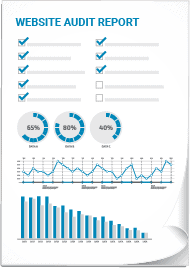Embarking on **how to redesign a website** feels like standing at the edge of a creative cliff, ready to dive into the digital depths below. Embarking on this adventure isn’t merely about giving your website a new coat of paint; it’s a pivotal chance to synchronize your digital domain with the shifting aims of your business and the anticipations of its users. Delving into this manual offers the keys to gauge existing performance indicators, gain a more nuanced comprehension of your target demographic via detailed buyer profiles, and harness design elements to elevate the overall user interaction. Plus, we’ll walk you through SEO optimization strategies that are crucial for visibility in today’s crowded digital landscape. So gear up—by the end of this read, you’ll be equipped with practical steps and data-driven objectives needed to steer your website towards success.
Table of Contents:
- Understanding the Website Redesign Process
- Identifying Your Target Audience and Buyer Personas
- Enhancing User Experience Through Design
- SEO Optimization Strategies for Your Redesigned Website
- The Role of A/B Testing in Website Redesign
- Set Data-Driven Objectives for Your Redesign
- The Execution Phase of Your Website Redesign Project
- Evaluating Post-Launch Success
- Conclusion
Understanding the Website Redesign Process
A website redesign is like giving your digital home a facelift. It’s not just about slapping on a new coat of paint; it’s about enhancing its functionality and making sure it meets current web standards. Embarking on this adventure involves first gauging the effectiveness of your present online metrics.
Benchmark Your Current Performance Metrics
Analyzing your site’s existing data gives you the lowdown on what works and what doesn’t. Think of Google Analytics as your best friend here, helping you to track everything from average time spent on pages to visitors bounce rate. Surprisingly, nearly 50% of websites snag between four and six page views per visit, highlighting the importance of engaging content right off the bat.

To get started, check out this guide on benchmarking your website’s metrics. You’ll discover how load times can affect visitor retention or how adding more compelling content might increase time spent on site.
Determine Your Website Redesign Goals
Crafting distinct objectives for your site’s makeover guarantees each modification harmonizes with your aspirations, whether it’s to enhance the user journey or amplify lead acquisition endeavors. Remember, half of consumers believe design significantly impacts brand perception which underscores why having specific targets is crucial in any website redesign plan.
Dive into shaping your goals with precision by leveraging our Website Redesign Strategy Workbook, a tool designed to meticulously align every aspect of your revamp towards the pinnacle of digital success. Whether aiming for better search engine rankings or more efficient navigation pathways for users—defining these aims early makes all subsequent steps clearer and more focused toward achieving business success.
Identifying Your Target Audience and Buyer Personas
Understanding who your website speaks to is like having a GPS in the vast world of digital marketing. It’s about knowing whether you’re talking to a busy marketing manager at a bustling startup or guiding a small company through its growth phase.
The secret sauce? Diving deep into creating detailed buyer personas. Imagine sketching out not just any audience, but the one that’s going to click, read, engage, and convert. It involves delving into specifics like the scale of the company and an individual’s position, which are pivotal in fine-tuning your communication for utmost impact.
To get this right, let’s talk specifics. For instance, identifying if your primary visitor is that ever-busy marketing manager can dramatically alter how you present information on your site. Do they seek brief fixes or in-depth tutorials? Understanding these nuances makes all the difference.
Determining Company Size: The Bigger Picture
When we dive into the specifics of a company’s size to identify its target audience, we’re essentially decoding unique demands and obstacles they encounter—this is a pivotal move for tailoring content strategies with precision. Larger organizations might prioritize scalability features while smaller businesses could be seeking cost-efficiency tips.
This approach isn’t just theoretical; it’s backed by hands-on experiences from countless web design projects where understanding the client’s business scale upfront led to more targeted designs and better outcomes overall.
Crafting Detailed Buyer Personas
Crafting buyer personas goes beyond demographics—it’s about empathy. It involves stepping into their shoes (or office chairs) to grasp their daily struggles and aspirations fully. Diving deep into this method often reveals key insights that significantly alter the direction of content strategy, pushing it towards narratives that are more captivating and uniquely designed for the audience.
Enhancing User Experience Through Design
Choosing the Right Color Palette and Style Guide
The choice of colors for your website does more than just appeal to the eye—it plays a crucial role in shaping emotions, guiding actions, and impacting choices. Think of it as your silent salesperson. Selecting hues that resonate with your brand’s essence not only beautifies your website but also boosts legibility and encourages visitor interaction. Ever wonder why most social media platforms use blue? Using the right colors, like blue, fosters trust and sparks conversations among your audience.
In mastering the art of website aesthetics, think about adopting a style manual as your master plan. By maintaining uniformity on each webpage, it solidifies a brand’s identity in the minds of those who visit. Companies with structured conversion optimization strategies are twice as likely to see an increase in sales—color choice plays a significant role here.
Poor web design can negatively impact conversions and sales significantly; choosing the right color scheme is crucial in avoiding this pitfall.
A/B Testing Key Elements
Guesswork has no place in effective web design; that’s where A/B testing comes into play. By comparing two versions of a webpage element (like CTA buttons or layout), you can see which one performs better regarding metrics such as lower bounce rates or higher conversion rates.
Adopting a strategy fueled by data not only facilitates minor tweaks that collectively elevate the user’s journey but also significantly boosts your financial outcomes. The Free On-Page SEO Template splendidly illuminates the pivotal role meticulously crafted components play in propelling SEO triumphs.
The Role of Continuous Monitoring
Evaluating post-launch success doesn’t stop after going live—the importance of continuous monitoring cannot be overstated. Keeping an eye on key performance indicators lets you understand traffic patterns over time Website Redesign Strategy Workbook.
SEO Optimization Strategies for Your Redesigned Website
When you launch a redesigned website, it’s not just about a fresh look. Moreover, it’s an ideal moment to elevate your site’s visibility in search engine results. Embarking on this venture not only enhances the aesthetic appeal of your website but also amplifies its visibility, attracting a wider audience to admire and engage with your revamped digital presence.

To start, competitive analysis is your secret weapon. Diving into the strategies of leading rivals reveals insights that allow you to craft your approach, ensuring you stand out in the fiercely contested arena of search engine rankings. Leveraging platforms such as SEMrush or Ahrefs provides essential intelligence on keyword utilization and the intricacies of backlinking tactics.
A solid redesign isn’t complete without considering search engine optimization from the get-go. Integrating SEO best practices during the design phase saves headaches later on.
Choosing Keywords Wisely
Finding the right SEO keywords is crucial for visibility online but don’t just stuff them everywhere. Use them thoughtfully in titles, headings, meta descriptions, and throughout content where they fit naturally.
The key here is relevance and balance; think quality over quantity every time you include an On-Page SEO Template.
Analyzing Performance Metrics Post-Launch
Your work doesn’t stop once your newly designed website goes live—monitoring its performance becomes essential next step. Google Analytics will be your go-to tool here because it lets you track everything from web traffic sources to user behavior patterns such as average time spent on pages or bounce rates.
Incorporating Continuous Competitive Analysis
Lastly keep eyes open wide with ongoing competitive analysis even after relaunching. As market trends shift, so should strategy ensuring long term success of redesigned platform this way staying ahead curve always possible. So there we have robust foundation built upon which attract organic visitors steadily increasing their engagement brand’s digital presence evermore impactful manner thanks well-thought-out SEO optimizations plan place.
The Role of A/B Testing in Website Redesign
Imagine stepping into a tailor’s shop, where instead of guessing, you could actually test which suit looks best on you. That’s the magic A/B testing brings to your website redesign process. By comparing two versions of a page (let’s call them Suit A and Suit B), we make data-driven decisions that can significantly improve performance metrics like bounce rates and conversion rates.
A/B Testing Key Elements
When it comes to redesigning your site, every detail matters – from the color of your CTA buttons to the layout of your landing pages. Yet, determining the most effective approach can often feel like navigating through a maze in the dark, right? Here’s where split testing becomes your secret weapon. It lets us serve different versions to users at random and analyze which one performs better based on hard data.
Utilizing this strategy goes beyond merely selecting the victors; it delves into deciphering the reasons some components excel over their counterparts. For instance, if Version B with a red CTA button gets more clicks than Version A with a blue one, it might tell us something about our audience’s preferences or even psychological triggers related to colors.
Dive into this revolutionary strategy by grabbing our complimentary On-Page SEO Blueprint. This tool will assist in refining every iteration for search engine visibility, all the while ensuring the user’s journey remains paramount. Keep in mind, when you’re navigating the realm of website creation, it’s often those minor tweaks that can catapult your performance indicators to new heights.
Set Data-Driven Objectives for Your Redesign
In the world of website redesigns, flying blind is a no-go. This means setting data-driven objectives is your first step to success. Why? Because nearly half of all websites snag between four and six page views per visit—a stat that could be music or mayhem to your ears, depending on where you stand.
To make sure it’s more symphony than cacophony for you, leverage tools like Google Analytics right from the get-go. These insights transform into vital clues, guiding you through the labyrinth of your website’s successes and pitfalls.
Benchmark Your Current Performance Metrics
Analyzing your current site’s performance metrics does more than give you bragging rights at industry mixers. It establishes the baseline for your journey’s beginning, a crucial step before diving into the treasure trove of data like load times and bounce rates that pinpoint exactly where enhancements are essential. Think about load times, bounce rates, and average time spent reading content—these are gold mines of information telling you exactly where improvements are needed.
The golden rule here: If it can’t be measured, it can’t be improved. So grab those metrics by their digital horns and start planning how to boost them in ways that align with your business goals.
Determine Your Website Redesign Goals
Once armed with hard data about how users interact with your existing web presence (or lack thereof), crafting clear-cut redesign goals becomes much easier—and way less guesswork involved. Whether increasing web traffic or improving lead generation efficiency is on top of your list depends largely on understanding these interactions inside out.
Plunge into formulating impactful tactics by engaging with our Guide to Revamping Your Website’s Strategy.
Revamping a site goes beyond mere aesthetic updates; it involves an intricate overhaul aimed at enhancing its overall functionality for users and optimizing its visibility to search engines.
The Execution Phase of Your Website Redesign Project
Once you’ve mapped out your website redesign plan, it’s time to jump into the execution phase. Now, we breathe life into our concepts, morphing them into concrete outcomes. However, keep in mind that an effective makeover goes beyond mere aesthetics; it’s fundamentally about aligning with business objectives and enhancing the experience for your users.
Get Started on Your Website Redesign Today
Kicking off your website redesign requires a solid foundation. Begin by selecting the optimal software and resources that match your project’s requirements. Embarking on a website makeover or crafting one anew, pinpointing the appropriate tech stack is vital to ensure both productivity and future growth.
Next up, collaborate closely with web developers and designers. These individuals are the artisans and architects who will transform your dream into reality. Make sure communication lines are always open to address any challenges swiftly as they arise during the entire process.
To save time later in the project, establish a style guide early on. This ensures consistency across all pages of the newly designed website—everything from color palettes to typography should be defined here.
Maintaining Focus During Execution
Maintaining focus during this phase means keeping an eye on those key performance indicators (KPIs) you set earlier based on insights from Google Analytics. By closely monitoring these indicators, you’ll be adept at refining every facet of your website—from how quickly it loads to its navigational layout—ensuring it not only ranks well in search engines but also captivates and retains visitors.
A/B testing plays a pivotal role here too; it lets you compare different versions of page elements like call-to-action buttons or headlines against one another so you can choose options that increase conversion rates most effectively.
Evaluating Post-Launch Success
After launching your redesigned website, the real game begins. It’s not just about celebrating; it’s about analyzing how well your site performs in the wild. Keeping a constant watch is essential to truly grasp the situation.

The Importance of Continuous Monitoring
Imagine launching a rocket and then ignoring its flight path. Sounds absurd, right? The same goes for your website redesign project. By keeping an eye on web traffic patterns post-launch, you get real-time feedback on what works and what doesn’t. This isn’t just about patting yourself on the back when numbers go up but also about quickly catching any issues before they become bigger problems.
For a more streamlined approach, think about leveraging instruments that monitor metrics such as bounce rate duration to enhance your understanding. Why focus on bounce rate time? Because it gives you insight into whether visitors find what they’re looking for or leave out of frustration or confusion. High bounce rates might indicate areas where your site needs further optimization.
Keeping an eye on things non-stop lets you catch which bits of your fresh website layout really draw people in. Are certain pages receiving more traffic than others? Do some pages have a significantly lower average time spent compared to others? By unraveling the mysteries behind which pages captivate visitors and where they hastily retreat, we can tailor subsequent enhancements with precision.
To start tracking these critical performance indicators effectively, check out Benchmark Your Current Performance Metrics. This resource will help set a baseline so you can measure progress accurately over time by comparing pre- and post-redesign data points such as load times, web traffic volume, visitor engagement levels (like increase in time spent), lead generation rates from new content sections versus existing ones—all crucial factors determining the success of any redesign effort.
Conclusion
Embarking on how to redesign a website, you’ve geared up with essential strategies. Having grasped the significance of establishing distinct objectives and profoundly comprehending your audience, you’re now poised to blend business targets with user expectations through vibrant color schemes and an improved browsing experience, while also unraveling the intricacies of SEO to distinguish yourself in the digital expanse. Picking out lively hues and boosting how people interact with your site, each phase aimed to marry the objectives of your business with the desires of its users.
Immerse yourself in the intricacies of SEO strategies; they’re vital for distinguishing your presence in the vast digital landscape. Bear in mind, experimentation is not merely a choice; it’s imperative. Exploring through A/B testing illuminates the path to what genuinely captures your audience’s attention.
The adventure doesn’t stop the moment you go live. Continuous monitoring lets you tweak and improve over time. With these insights, transforming your online presence becomes not just possible but practical.




